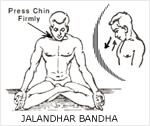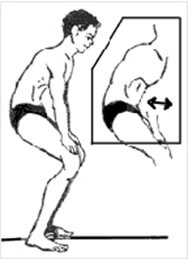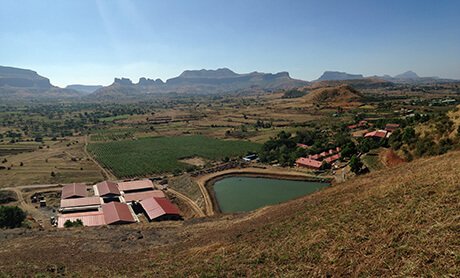A bandha may be defined as a particular action involving press ure or strain on the muscles. It is expected in Yoga to retain a firm pose in a bandha as it is retained in the asanas. The bandhas are to be studied mainly while studying pranayama but they also have their own individual effects. Bandha means to lock, hol d or tighten and aims to lock and move prana in particular areas.

It is difficult to explain why this bandh is known as Jalandhar Bandha . However, one may guess that Rishi Jalandhar might have defined the act of this bandh a for the first time, and it was therefore named after him.
If we try to trace the meaning of the word Jalandhar, "Jal" means "Net", in this case, net of Nadis (energy channels) and the word "D har" means to hold the flow of the fluid (Amrut), flowing through the nadis .
This bandha can be achieved withou t getting into any asana pose but generally it is practiced in Padmasan or siddhasan but any other meditative asana can be used.
In the meditative asana have the hands in either drone or dhyan mudra. Inhale slowly and deeply through the nose.
Contract the throat as if you are swallowing.
Bring the chin back towards the spine and gently press downward. It does not have to be a strong bend. Over time one will feel the compression of the windpipe.
Hold the bandha for as long as it is comfortable, then relax the throat, raise the chin and exhale slowly through the nose.
Repeat as many times as desired.
Thr oat, neck
Vishuddhi chakra, mental calmness, introversion
This bandha is the most important in practice of pranayama with breath retention. If one cannot practice Jalandhar bandha correctly then one cannot do pranayama. This is preparation for tribandha.
The pressure of the bandha slows th e blood supply to the carotid artery which sends a signal to the brain to balance the blood pressure, preventing it from increasing, which can occur in breath retention.
This bandha stimulates vagus nerve, which is a parasympathetic nerve. This is stimulat ing parasympathetic nervous system. Blood pressure, heart rate slows down. Muscles are more relaxed, and it creates calmness in the mind and removal of thoughts
Improves blood supply to the cervical region of the spine.
Prevents air from entering the eustachian tubes which causes pressure on the ear drums.
Good for thyroid gland especially hypo thyroid. It has good effect on regulation of metabolism.
Prevention of coughs, throat problems, it is good for vocal chords.
Induces introversion.
Emotional tension related to menstrual cycle
Beginners can practice from 4 seconds and slowly increase the time duration as per comfort. In the beginning doing 3 to 5 repetitions an d then increasing repetitions as per comfort.
Some people like to have their hands in drone mudra and arms straight. This causes a hunch in the shoulders but can help improve the Jalandhar bandha .
For those who find it hard to achieve th e lock one can practice by inhaling with ujjayi, this helps one to understand and start the contraction of the throat.
Deep breathing and/or ujjayi breathing
Samyakasan – where the hands are placed behind the body an d the head is tilted back to stretch the throat.
Jalandhar Bandha has been described in Hatha Yoga Pradi pi ka in the third chapter :
Meaning -
The chin is to be pressed on the chest after contracting the throat. This bandha eliminates old age and dea th. The contracted veins in the throat ensure that the liquid from the skies is received here. Hence, the bandha has been appropriately known as Jalandhar Bandha , which means that it destroys any pain in the throat.
Gherand s S amhita has also described the bandha :
Meaning -
The chin is to be pressed onto the heart after contracting the throat. This Ja landhar Bandh supports sixteen types of bandha s and destroys death.
Meaning -
Jalandhar Bandh is Swayamsiddha and the sadhaka who practises th is bandha for six months will, no doubt, achieve siddha status
In both the texts, the description as well as the effects of the bandha is more or less the same. Both the texts have assured that the bandha causes destruction of old age and death. Observin g this bandha g ives peace and calmness to both the heart and the mind. This in turn increases the lifetime of the sadhaka.
This bandha relates to mooladhar chakra and is termed as moola bandha. Moola means root or source.
This bandha is best performed in siddhasan as it helps give an automatic Moola Bandha and creates more awareness in this region. If siddhasan is difficult then one can sit in Padmasan or any other meditative asana.
In the sitting position close your eyes, relax and become aware of the area which is the trigger point for mooladhara chakra. For men it is the perineal area, between the anus and genitals. One must concentrate on that area and just slightly in, about 1 c m, is the trigger point. For women the place is at the point of the cervix, where the uterus joins the vagina. The perineal muscles are also used. It can be very difficult to isolate these points as there is a tendency to also contract the anal and urinary sphincters. Over time one learns how to isolate the muscles.
There are a few ways to practice. One can just concentrate on this area, breathe normally and contract and relax as many times as is comfortable.
Another way is to inhale and contract, hold for a few seconds, and then exhale, relaxing. Repeating as per comfort.
Another is to contract, breathe normally and hold the bandha for as long as one can, then slowly release.
This bandha can also be practiced in certain balancing asanas to improve balance.
It is also beneficial if one contracts and pulls upward slightly.
Perineal area or cervix.
Mooladhar chakra
As many times as is comfortable. The bandha can also be held for up to 5 minutes over time.
If siddhasan is difficult one can slightly bring the foot under the thigh and move the body forward so that the heel more easily presses against the body and improves the moola bandha.
Siddhasan
Tribandha and pranayam
The bandha has been describe d thoroughly in t he third chapter of Hatha Pradi pika.
Meaning -
The heel should press the perineum, the muscles should be contracted and the gas (apan vay u) should be lifted upwards. This results in moola bandha . Further it is described as:
Meaning -
Apan vayu is generally in the downward direction. With deliberate contraction the apan vayu is lifted upwards. This is known as moola bandha . The bandha is to be performed till the time the gas is forced upwards. Hatha Yoga Pradipika, in further shlokas, describe this bandha as when the prana, apan, the sound and the point (nad and bindu) will merge with each other due to this bandha , then one can be said to succeed in yoga.
The effects of this bandh are described as under:
Meaning -
The regular study of moola bandha results in merging apan and prana. The exc retions are minimised and an old person turns into a young one. Though, as a matter of practice, an old person may not be transformed into a youth, the general meaning can be guessed as the disappearance of the signs of old age with return of the enthusias m of youth.
The next four shlokas in Hatha Yoga Pradipika describe how the bandha is related to awakening of Kundalini power. Hatha Yoga Pradipika says that when the apan vayu is forced upwards it enters the vanhimandal. The pressure of this vayu results in increasing the fire. Apan vayu and this fire heat the prana. This results in igniting the fire in the stomach. The kundalini power, which is supposed to be asleep, awakens like a snake hit by a stick. It then enters the sushumna nadi (brahma nadi) like a snake entering its hole. Hence, every sadhaka must study moola bandha regularly.
The thirteenth shloka in the third chapter of Gherand Samhita describes this bandha . The description is as given above as in Hatha Yoga Pradipika.
However, the effects of this bandh are described as:
Meaning -
This is a superior type of bandha which results in reversal of old age and the death. The study of this bandha res ults in fulfilment of any desire. This description is a bit exaggerated but one can understand its importance on health.

This bandha or lock involves the movement of the muscles of the abdomen and especially the diaphragm. Hatha Yoga assigns a special importance to Uddiyan Bandha and the study of pranayama is not complete without studying this lock. While performing this lock the muscles of the diaphragm are pulled in an upward direction; Uddiyan in Sanskrit i s moving up hence this bandh is termed as Uddiyan Bandha. This lock is also useful for awakening of Kundalini Shakti which is another reason the name is there, for raising the energy upward.
The lock involves the action of the muscles of the abdomen and hence it may be performed while in a standing pose or sitting pose. The bandha can also be performed in Padmasan, Siddhasan, Vajrasan or any other meditative asana. However for best results, an d especially when learning, it is best to perform the lock in a standing position.
Stand with a distance of 1 to 1.5 feet between the legs
Bend the knees as if one is about to sit in a chair and place the palms firmly on the knee s. The pressure should be on the arms so that the abdomen can relax.
Bend the shoulders a little towards the front and the neck slightly downward.
Inhale deeply and then exhale either through the nose or mouth. While exhaling, try to pull the muscles of the abdomen inwards. Lift up the ribs a little bit and pull the muscles from within with a gentle push upwards. The muscles of the abdomen must be relaxed at this time, so that they can be pushed up. These results in the muscles of the diaphragm being pus hed upwards and a vacuum created in abdomen. This is the final stage of Uddiyan Bandha.
Try to remain firmly in this pose for as long as one can hold the breath out comfortably.
When one needs to inhale slowly release the bandha by releasing the muscles o f the abdomen back to the normal position. The diaphragm will also be restored to its normal position.
Relax the strain in the shoulders and neck area and start inhaling gradually.
After inhaling completely, bring the arms by the side and straighten the le gs.
Optional but strongly recommended – after completion of Uddiyan bandha lie in shavasan and very gently press the abdomen, in the direction of the large intestine. This helps to relax the abdomen.
when releasing the bandha one may inhale, r aising the arms up over the head and exhaling lowering the arms down. This can be helpful if there is any tension in the neck.
Abdomen being pulled in and up
Manipur chakra, Navel region, external breath retention, relaxation, stillness
The muscles of the diaphragm are well exercised and this movement therefore helps improve breathing.
The organs in the abdomen develop a negative pressure. Due to this pressure, the blood supply to these organs is improved . The difference between the negative pressure during this bandh and the normal pressures resumed after relaxation increases friction on the internal organs such as the stomach, small intestines, liver and pancreas thereby improving their efficiency. This also results in improving the secretion of the digestive juices, improving the digestive function.
It is stated in various ancient texts that apart from these benefits, the bandh is also useful for spiritual progress and awakening of Kundalini power.
It is very important for practice this bandha independently as a preparation for tribandha and pranayama.
Stimulates the digestive fire and appetite is stimulated,
Tones liver, pancreas, adrenals, urinary and excretory systems. Removes impurities and improve s the efficiency of all the organs.
Excellent practice for helping depression, also removes fatigue and lethargy.
Stimulates vagus nerve which is stimulation to parasympathetic nervous system and that brings mental, physical relaxation and peace.
Improves blood supply throughout the whole torso
Reverses the flow of apana and prana, causing union with samana and maipur chakra.
Stimulation of manipur chakra, the energy distribution centre, increases pranic energy.
Balances all 5 pranas in the body.
Avoid if there h as been any abdominal surgery, high blood pressure, hear t disease, ulcers, diarrhoea, menstruation, hernia, intracranial pressure, glaucoma, pregnancy or acidity. Always practice on an empty stomach and if possible, empty bladder and bowels.
3 - 5 rounds can be practiced, holding for 10 seconds or as long as is comfortable. Slowly the time duration can be increased up to 1 minute.
Sometimes making a false inhalation by trying to expand the chest as if one is breathing in Uddiyan bandha can help improve the bandha as it helps to pull the diaphragm upwards.
Agnisar Dhouti
Tribandha and pranayam
The third chapter in the Hatha Yoga Pradipika describes ten mudras. Uddiyan bandh has been described as one of the mudras. The writer of Hatha Yoga Pradipika explains why this mudra is termed as Uddiyan bandha as follows :
Meaning -
The prana in the body is raised due to the performance of this bandha , hence this bandha is termed as Uddiyan bandha .
The action of this bandh is described below :
Meaning -
The abdomen is to be pulled (stretched) inwards and the navel upwards. This process is known as Uddiyan bandha . This action is like a lion kill ing an elephant which represents death. Nowhere in the process is it described that the bandha is to be performed after exhalation. This part was taught as a matter of master – disciple tradition and hence perhaps not explained in detail in the shloka.
The effects of this bandh have been described below:
Meaning -
If the bandha is practised constantly and regularly as taught by the Guru, even an old man can be reverted into a young one. The effects have been a bit exaggerated however the hidden meaning is to be understood. The bandha causes certain beneficial effects on the body, which in turn result in a youth like state of the body, full of enthusiasm.
The n ext shloka describes:
Meaning -
If a sadhaka practices stretching the navel, the portion below the navel and the upper part of the abdomen towards the back and upward direction regularly for a period of six months, there is no doubt that he can win over death. This description is also a bit exaggerated however the logic behind it must be understood. We should not blindly believe that practising this ban dah for six months will win over the death, but we should still practice this bandha regularly so that its beneficial effects on the body will result in increasing our life span. A shloka after this describes that the study of this bandha results in leadin g the sadhaka easily onto the path of mukti (liberation).
Phone - +91-9822770727
E-mail - yoga@yogapoint.com or yogapoint108@gmail.com

Yoga Vidya Dham, Kaivalya Nagari,
College Road, Nashik - 422005.
Maharashtra, India.
Phone - +91-9822770727 (for courses in ENGLISH)
+91-253-2318090 (For courses, in HINDI or MARATHI)
(Please call during 9.00 AM to 5 PM Indian Time)
E-mail - yoga@yogapoint.co or yogapoint108@gmail.com
Village Talwade, Trimbak, Nasik
Maharashtra,India.
Phone - +91-9822770727
E-mail - yoga@yogapoint.com or yogapoint108@gmail.com